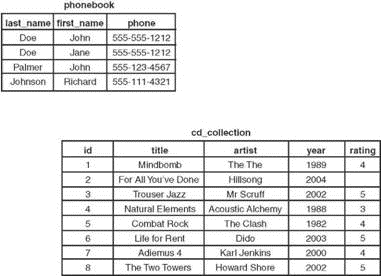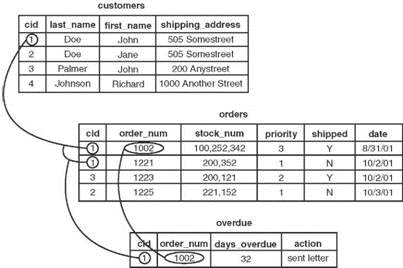Книга: Fedora™ Unleashed, 2008 edition
How Relational Databases Work
How Relational Databases Work
An RDBMS stores data in tables, which you can visualize as spreadsheets. Each column in the table is a field; for example, a column might contain a name or an address. Each row in the table is an individual record. The table itself has a name you use to refer to that table when you want to get data out of it or put data into it. Figure 18.1 shows an example of a simple relational database that stores name and address information.

FIGURE 18.1 In this visualization of how an RDBMS stores data, the database stores four records (rows) that include name and address information, divided into seven fields (columns) of data.
In the example shown in Figure 18.1, the database contains only a single table. Most RDBMS setups are much more complex than this, with a single database containing multiple tables. Figure 18.2 shows an example of a database named sample_database that contains two tables.
In the sample_database example, the phonebook table contains four records (rows) and each record hold three fields (columns) of data. The cd_collection table holds eight records, divided into five fields of data.
If you are thinking that there is no logical relationship between the phonebook table and the cd_collection table in the sample_database example, you are correct. In a relational database, users can store multiple tables of data in a single database — even if the data in one table is unrelated to the data in others.
For example, suppose that you run a small company that sells widgets and you have a computerized database of customers. In addition to storing each customer's name, address, and phone number, you want to be able to look up outstanding order and invoice information for any of your customers. You could use three related tables in an RDBMS to store and organize customer data for just those purposes. Figure 18.3 shows an example of such a database.

FIGURE 18.2 A single database can contain two tables — in this case, phonebook and cd_collection.
In the example in Figure 18.3, we have added a Customer ID field to each customer record. This field holds a customer ID number that is the unique piece of information that can be used to link all other information for each customer to track orders and invoices. Each customer is given an ID unique to him; two customers might have the same data in their name fields, but their ID field values will never be the same. The Customer ID field data in the Orders and Overdue tables replaces the Last Name, First Name, and Shipping Address field information from the Customers table. Now, when you want to run a search for any customer's order and invoice data, you can search based on one key rather than multiple keys. You get more accurate results in faster, easier-to-conduct data searches.

FIGURE 18.3 You can use three related tables to track customers, orders, and outstanding invoices.
Now that you have an idea of how data is stored in an RDBMS and how the RDBMS structure enables you to work with that data, you are ready to learn how to input and output data from the database. This is where SQL comes in.
- SERVER WORKING SIZE
- How to read
- Chapter 9. How a rule is built
- How it was written
- How to plan an IP filter
- chown
- How to place proxies
- 7. AGGREGATION WITH INDEPENDENT WORKS
- How to use this License for your documents
- 2. How to Apply These Terms to Your New Programs
- Глава 3 Виртуальные машины VMware Workstation
- Глава 4 Виртуальные машины Parallels Workstation




